
Original Link: https://www.anandtech.com/show/1548
AnandTech Guide to Better Photos: Composition
by Stephen Caston on November 19, 2004 12:05 AM EST- Posted in
- Digital Camera
Index
Welcome to our first article of the AnandTech Guide to Better Photos. With these articles, we hope to inform and invoke discussion on the topic of photography-related techniques and tips. To start off this series, we are going to look at some compositional concepts that can help improve your photography.Composition is the arrangement of elements in a picture, but we are going to be discussing specifically arrangements that will make your pictures more visually appealing and interesting. When dealing with composition, it does not matter if you have a high-end digital SLR or a cheap point-and-shoot. In fact, experimenting with composition might be easier to do with a point-and-shoot camera because the simplicity of the shooting process will allow you to concentrate on what you are looking at. The purpose of this article is not to tell you how to take great pictures. Instead, we want to offer some basic principles of composition to stimulate photographic thought. Keep in mind that it is important to think of compositional concepts as guidelines, not rules. In the end, we want you to take these ideas and to use them as aids in composition.
Simplicity, ROT, Lines & Curves
Simplicity
Before discussing ways to compose an appealing image, you must first have a clear idea of what you are shooting. Before framing a shot, ask yourself, "What is/are my primary subject(s)?" By asking this question, you should also begin to understand what you are not shooting. For example, look out for distracting scenery or objects that might compromise the prominence of your primary subject. By mentally defining your subjects and "non-subjects", believe it or not, you have already begun composing your shot. Now, you can begin framing your image in the viewfinder or LCD screen.One of the first ideas that we will discuss is to simplify the arrangement so that your viewer's eyes are immediately drawn to the subject. For example, you do not want a bunch of excess clutter around the edges of the frame that simply would detract attention from the main subject. One way to remove unnecessary clutter is to change your shooting position or to use your camera's zoom. In the example below, the image on the left has a significant amount of clutter on the bottom of the frame. Additionally, there are some distracting bits on the left and right sides. In this circumstance, we were unable to move closer to eliminate the clutter. However, we did have the ability to zoom in further to achieve the more striking and simple image on the right.
 |
 |
In the image below, we have employed another commonly used simplification method - simply, to fill the frame. By doing this, we have effectively eliminated elements that could be in competition with the subject. Other than moving or zooming to exclude objects, you can also eliminate background clutter by selecting a large aperture setting on your camera. As a result, you create a small depth-of-field, thereby blurring the background and detracting attention from it.
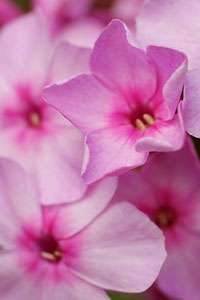
In any case, simplifying your composition will make your pictures much more effective. It gives the viewer's eyes an easier time of finding your subject, which also means instant impact.
Rule of Thirds
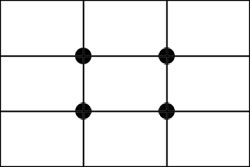 |
Below is an example of the ROT in action. Notice that the eyes and head of the subject are centered at the upper-right intersection.
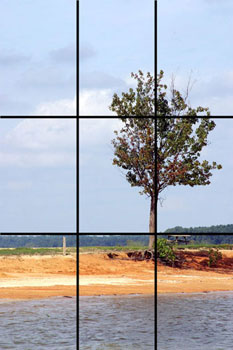
Hold mouse over image to see ROT lines
To see more pictures that use the ROT as an underlying compositional tool, take a look at some of your favorite pictures. You will probably find that the imaginary ROT lines are at work in many of the pictures you find appealing. In most circumstances, pictures with subjects along the ROT intersections/lines simply look better than other pictures. You should by no means take this "rule" to be the ultimate decider of good pictures; the ROT is simply a common compositional tool. Do some experimentation with the ROT in your own pictures. Whether or not you choose to use it as a primary compositional tool, you should at least be aware of its presence.
Lines and Curves
Lines and curves can be used to direct attention to subjects and to give form to a picture. You will find lines everywhere as you are out shooting. If you are aware of them, you can incorporate them into your compositions to improve your pictures. Below are two examples of how lines can be used: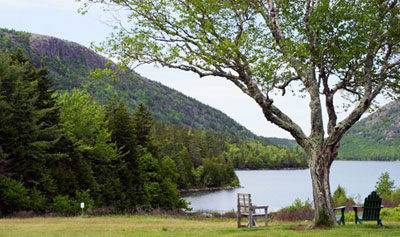 |
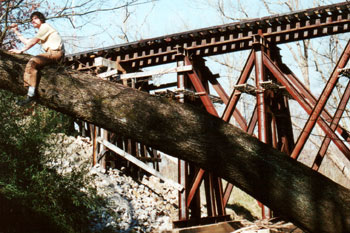 |
In the first image, the lines formed by the mountains lead into the main subject (the tree and chairs). In addition, the tree branches themselves bring attention down to the lower right portion of the frame. In the second image, the fallen tree and the railroad track lead the viewer's eye to the subject in the upper-left corner. Another great way to make your pictures interesting is to use curves. Below is an example using the popular "S" curve.

In the picture above, the "S" curve, along with the downward slope of the hill, add a certain dynamic to the picture that gives the viewer a sense of movement and rhythm. There are many who think that the "S" curve makes for the most beautiful pictures. At the very least, any camera-wielding photographer would be hard-pressed to pass up the opportunity to shoot one of these curves.
Balance and Space
Now, we are going to take a look at balancing different elements in your composition. It is important to be aware of the "weight" that objects have in a picture. By "weight", we are referring to the attention that each object receives from the viewer. Weight can be affected by the color, size, tone, etc. of the elements in your pictures. For example, in a picture with all black and white objects, a red strawberry will receive the most attention. When you take a picture with several elements, you should be aware of the balance created by the weight of these elements. In general, people prefer pictures that appear to have some sort of balance to them. Additionally, quite often the most obvious balancing methods are also the most boring.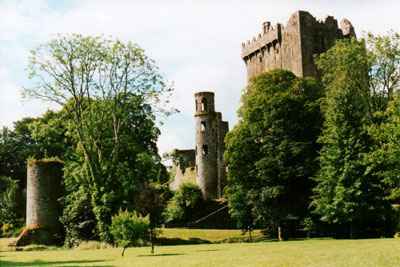
In the image above, the larger (and mostly hidden) castle on the right is balanced with the smaller structure on the left side. The size difference in this balanced image creates an interesting dynamic. If you think of the middle castle as the fulcrum, you can see how the smaller subject on the left is able to balance the large castle on the right by being positioned further from the center.
We also want to talk about the effects of using space as a balancing element. Using space in pictures is often a welcomed change from the "fill the frame" approach.
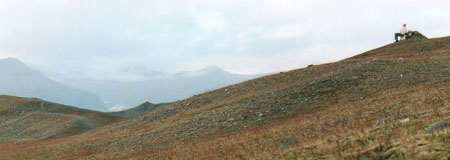
In the image above, we have offset the subject sitting on a rock at the upper-right with the open space of mountains on the left. Notice how this arrangement can create an atmosphere of contemplation or isolation. In general, space can be used to evoke the imagination of the viewer. For example, "leading" space can be used to give the impression of movement. This is done by leaving extra space in the direction that a subject is facing.
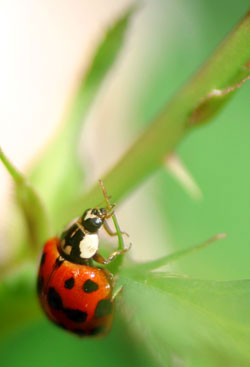
By positioning this ladybug at the lower left of the frame, we were able to give the viewer the impression of movement. Also, notice that by selecting a large aperture opening, we were able to blur the distracting background elements. "Leading" space is a common-sense concept that is also used by movie directors to give the audience an idea of where a character is headed. A good example of the importance of leading space can be seen in horror films. You know something bad is going to happen when a character is backing up, yet there is no leading space to show where he/she is going. In this sense, the inclusion of leading space in the frame can be a comfort to the audience.

Here, we chose to leave some empty space in the frame opposite the cat. If the space on the left were cropped out or simply not included in the shot, the picture would have a very awkward appearance. By allowing for some empty space in the direction of the cat's gaze, we were able to provide a better balance and a far more intriguing picture. As you can see, balance can play a very important role in the effectiveness of pictures. We really want to stress that although space is commonly neglected as a compositional tool, it can be very powerful.
More Ideas
In addition to the compositional concepts, which we have already mentioned, there are a few more points that we would like to bring up. Something that rarely occurs to people is the importance of perspective when shooting. If many of your shots are taken at eye level while standing, they will all have a similar "look" to them. However, if you experiment with different camera angles and perspectives, you will probably find that the results are far more interesting than "standard" perspective pictures.
In the picture above, we used a low angle approach to highlight the strong contrast between the dark red stop sign and the dark blue sky. By using this low angle, we were able to simplify the image by removing distracting background elements that would have appeared in a "standard" perspective shot.
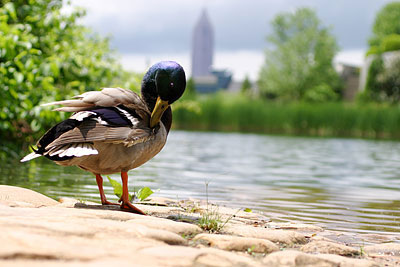
Don't hesitate to get down on the ground. In this picture, we were able to contrast this duck against the Atlanta cityscape by lying on the ground by this pond.
One of the most important things to keep in mind with composition is to stay creative. Experiment with different angles and compositions that you haven't tried before. With a digital camera, there is absolutely no excuse for a lack of experimentation. If the picture turns out bad, you can just delete it before anyone else sees it. This is really the only way to develop an eye for your unique photographic style.
Another way to build your compositional awareness is to look for pre-existing compositions around you. Bring your camera with you whenever possible and you may find some unlikely subjects.
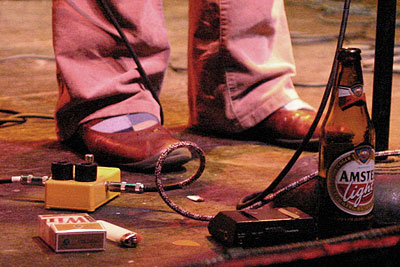
For example, at this concert, something struck us about the circular arrangement of this singer's feet, the beer bottle, cigarettes with a lighter, and effects pedal. If you see "naturally" occurring compositions, you may feel compelled to photograph them and this is a great way to experiment with different composition ideas.
On a similar subject, we want to challenge you to take good pictures of ordinary things. Too many people think that to take an interesting picture, you must have interesting subjects. A good example of this line of thought is that people are often waiting to see something present itself as a "photo op". This passive way of thinking is sure to present you with few pictures and very little experience. The real challenge is to exercise your ability to turn any situation into an opportunity for good pictures. So please, especially if you have a digicam, shoot away and try out new things. You have absolutely nothing to lose. The worst that you can do is improve your photographic ability.
Hopefully, you've been able to take something from this first article of our AnandTech Guide to Better Photos. At the very least, we hope that you will become more aware of your composition when shooting. The smallest adjustments can make the biggest differences in your pictures. With this article, our goal is to make you aware of some basic concepts for improving your own photography. Keep in mind, though, that all the theory in the world won't produce better pictures - only shooting can do that! In our next article, we will take a look at some techniques for taking great portrait pictures. Until then, get out there and compose!







